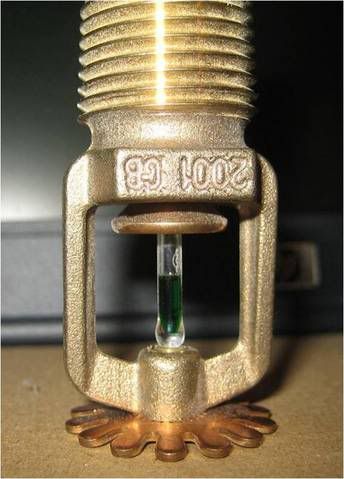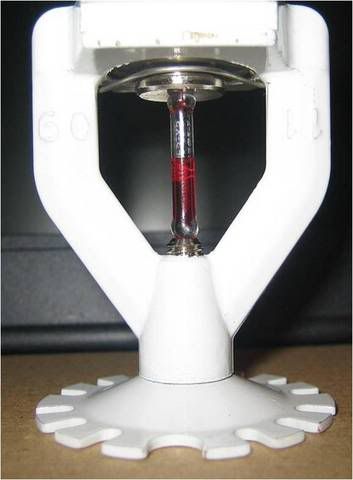Insurance Engineer
Registered User
I saw this on another board and think it is was something we should be on the lookout for. I hope it is not a problem posting it here, if it is moderators then please delete.
From
Jon Nisja, Supervisor
MN State Fire Marshal Division
Our office has seen a significant number of glass bulb sprinklers only partially filled with fluid. They have come from different jobs, done by different contractors, at opposite ends of the state, and by different manufacturers. The majority of the sprinklers sold here are Tyco and Reliable models. We have been in contact with both manufacturers; they seem to indicate that they have not heard of this from anyone else but us. The engineers at Reliable have advised us that the sprinklers will not activate at the rated temperature; it would likely take temperatures hundreds of degrees higher to activate the sprinklers.
We have also seen a number of completely empty glass bulb sprinklers; these could often be traced to mechanical damage. There seems to be no logical explanation as to how some of the fluid left the glass bulb. From what we have found out, the glass bulb is made by two manufacturers; both of them in Europe. They are then sold to the various sprinkler manufacturers and installed in their sprinklers. Both the glass bulb manufacturers and the sprinkler manufacturers claim that all glass bulbs and sprinklers undergo a rigorous testing and inspection program. What is frustrating to us is that it appears that these defects are not noted in the glass bulb manufacturing process, the sprinkler manufacturing process, or the actual installation (by sprinkler contractors and fitters). We have collected 6-8 of these sprinklers from various installations (some new and some existing) across the state.
Yesterday, we had a meeting with several sprinkler contractors and one of them advised us that they received a case of sprinklers recently; several of these glass bulbs were partially full. They sent them back to the manufacturer.
We have also had a handful of instances of glass bulb sprinklers losing the coloring of the fluid (they are clear). Although this makes it difficult to determine the activation temperature, we are less concerned that they will not activate than the partially filled glass bulb sprinklers. Again, the manufacturers have no explanation and claim that they have not heard of it from other parts of the country.
Since many of the E-PARADE members have extensive experience with sprinklers, we are looking for your comments, advice, or suggestions. I have attached a couple of photos. Has anyone else seen this? Does anyone have any theories on what is happening?


From:
Dana Haagensen
Fire Protection Engineer
Division of Fire Safety
Massachusetts Department of Fire Services
Jon - This issue came up on the NFPA Committees a few years ago. I don't believe who is to blame was ever resolved. There was a lot of finger pointing between the manufacturers and the installing contractors. However, the debate is what led to the listing labs, and the manufacturers, to come up with the protective shipping caps. NFPA requires those covers to remain in place until after the sprinkler has been installed. In some case, the cover must remain in place until the system is put into service.
Manufacturers claim these defective bulbs must be field/shipping induced, as every glass bulb is factory tested.
Contractors claim the phenomenon occurs even when sprinklers are properly installed and/or the defective sprinklers are shipped that way.
In my inspections, I have run into only one glass bulb with no fluid in it. I can't recall running into a partially filled bulb. I have talked to some inspectors that have run into a couple of colorless fluid filled bulbs. To my knowledge, the colorless ones were related to sunlight exposure (uv fading), as they were located in skylights or near windows.
We should encourage that all defective sprinklers be submitted to the Consumer Product Safety Commission (CPSC) so that they can properly track the situation by make/model and look for nationwide trends. If you haven't already done so, you should befriend your local CPSC investigators.
From
Jon Nisja, Supervisor
MN State Fire Marshal Division
Our office has seen a significant number of glass bulb sprinklers only partially filled with fluid. They have come from different jobs, done by different contractors, at opposite ends of the state, and by different manufacturers. The majority of the sprinklers sold here are Tyco and Reliable models. We have been in contact with both manufacturers; they seem to indicate that they have not heard of this from anyone else but us. The engineers at Reliable have advised us that the sprinklers will not activate at the rated temperature; it would likely take temperatures hundreds of degrees higher to activate the sprinklers.
We have also seen a number of completely empty glass bulb sprinklers; these could often be traced to mechanical damage. There seems to be no logical explanation as to how some of the fluid left the glass bulb. From what we have found out, the glass bulb is made by two manufacturers; both of them in Europe. They are then sold to the various sprinkler manufacturers and installed in their sprinklers. Both the glass bulb manufacturers and the sprinkler manufacturers claim that all glass bulbs and sprinklers undergo a rigorous testing and inspection program. What is frustrating to us is that it appears that these defects are not noted in the glass bulb manufacturing process, the sprinkler manufacturing process, or the actual installation (by sprinkler contractors and fitters). We have collected 6-8 of these sprinklers from various installations (some new and some existing) across the state.
Yesterday, we had a meeting with several sprinkler contractors and one of them advised us that they received a case of sprinklers recently; several of these glass bulbs were partially full. They sent them back to the manufacturer.
We have also had a handful of instances of glass bulb sprinklers losing the coloring of the fluid (they are clear). Although this makes it difficult to determine the activation temperature, we are less concerned that they will not activate than the partially filled glass bulb sprinklers. Again, the manufacturers have no explanation and claim that they have not heard of it from other parts of the country.
Since many of the E-PARADE members have extensive experience with sprinklers, we are looking for your comments, advice, or suggestions. I have attached a couple of photos. Has anyone else seen this? Does anyone have any theories on what is happening?


From:
Dana Haagensen
Fire Protection Engineer
Division of Fire Safety
Massachusetts Department of Fire Services
Jon - This issue came up on the NFPA Committees a few years ago. I don't believe who is to blame was ever resolved. There was a lot of finger pointing between the manufacturers and the installing contractors. However, the debate is what led to the listing labs, and the manufacturers, to come up with the protective shipping caps. NFPA requires those covers to remain in place until after the sprinkler has been installed. In some case, the cover must remain in place until the system is put into service.
Manufacturers claim these defective bulbs must be field/shipping induced, as every glass bulb is factory tested.
Contractors claim the phenomenon occurs even when sprinklers are properly installed and/or the defective sprinklers are shipped that way.
In my inspections, I have run into only one glass bulb with no fluid in it. I can't recall running into a partially filled bulb. I have talked to some inspectors that have run into a couple of colorless fluid filled bulbs. To my knowledge, the colorless ones were related to sunlight exposure (uv fading), as they were located in skylights or near windows.
We should encourage that all defective sprinklers be submitted to the Consumer Product Safety Commission (CPSC) so that they can properly track the situation by make/model and look for nationwide trends. If you haven't already done so, you should befriend your local CPSC investigators.
Last edited by a moderator:
